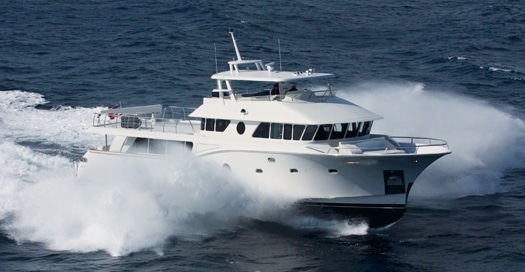
ytgfeb22argos525.jpg
As the captain wheeled our skiff through the rolling sea and into the lee of the breakwater, I loosened the zipper of my jacket. Clouds that had ganged up since the morning now scudded across the sky, allowing only glimpses of the blue beyond. These clouds had managed to chase us from the bonefish flats-another cold front had arrived, and the welcoming stern of the Argos Yachts Gulfstream 92 was a pleasant sight, since the wind was howling and the air temperature barely reached 60 degrees. Hard to believe this was the Bahamas.
I was paying a visit to Dave Adams, senior vice president of Argos Yachts, aboard the G92 as she sat dockside at Old Bahama Bay, a resort and marina in West End, Grand Bahama Island. Adams’s passion for the yacht comes through, as does his excitement for recreation, Bahamas-style. The previous day, Adams greeted me on the dock with a grin, in sweatshirt and jeans, saying that he had booked a day of bonefishing, just as the anenometer touched 20 knots.
The fishing turned out to be surprisingly productive, with Captain Tommy Rolle connecting us with five speedy bonefish, and I blew many more shots. As we bid our guide farewell, Adams opened the watertight door on the swim platform, and disappeared into the spacious lazarette, emerging with a pair of wet suits. We were going snorkeling for lobster. Talk about earning your dinner!
A few hours later, over grilled lobster tails, steaks, and cabernet sauvignon, we discussed the hull form of the G92. “She has an absolute perfect hull design, for her intended purpose,” says Adams, clearly proud of his work with Howard Appollonio.
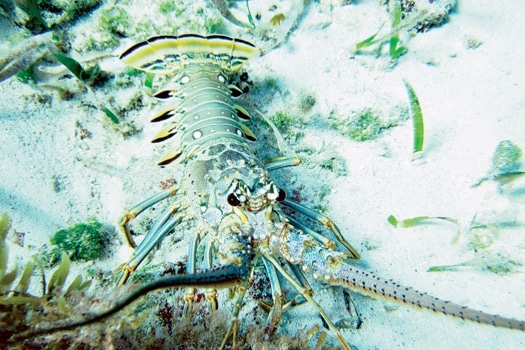
| | |
The modified bow shape with convex surfaces takes away the rudder effect that steers a yacht off course in a following sea. “We started with a 55-degree deadrise, but then we bowed it out,” says Adams. “When you’re in a quartering sea, which normally will slap against a flat or concave surface, it disperses around the round surface, softening the ride while also getting rid of your rudder [effect] in following seas. But it is still phenomenal in a head sea.” The hull was designed to have a 5-foot, 6-inch draft, yet be stable in a variety of sea states.
A pair of 1,650-horsepower Caterpillar C32 diesels give speeds up to 26 knots, and a slow cruise of 9 knots with a range of 3,000 nautical miles. A cruising speed of 23 knots, at around 2100 rpm, will get the Argos where she needs to go and optimize time aboard, but still leave a few knots of reserve speed to skirt storms. When I asked Adams about the yacht’s purpose-after all, “perfect” is quite a claim-he led me to the pilothouse and spread a chart on the dinette.
There before us were the Bahamas: Cruising ports and marinas interspersed with remote anchorages and pristine waters for fishing, diving, and cruising, with warm sun and cooling breezes. And in between, there is arguably the largest variance of water depth in such a compressed space anywhere, from the Tongue of the Ocean, thousands of feet deep, to flats that lie just a fathom beneath the surface.
The Bahamas hold the kind of cruising that Adams had in mind as he worked out the design of the G92. But this design was about more than just island-hopping: The exposed ocean passages that bring a yacht to this sheltered reward also received substantial consideration. Adams draws on his experience: teaching sailing when he was 12, serving as mate and skipper on fishing boats, running tugs in the Gulf oilfields-he says he stopped counting days at sea at 2,000 when he was just 23. His understanding of the meeting of hull and water served him as a yacht broker in Palm Beach, and it played a role in the design of this 92-footer.
So Adams knows boats and changing sea conditions. He also knows that a workable design places paramount importance on the comfort of those aboard. “It had to have stability and a low center of gravity,” says Adams. “It had to be great in a head sea, great in a beam sea, great in a quartering sea, great in a following sea.” Outlining these requirements, Adams is also explaining the demands of a client, Christos Livadas, who founded and is now chairman and CEO of Argos Yachts, and Tricon Marine, the shipyard in Zhuhai, China, where the Argos was built.
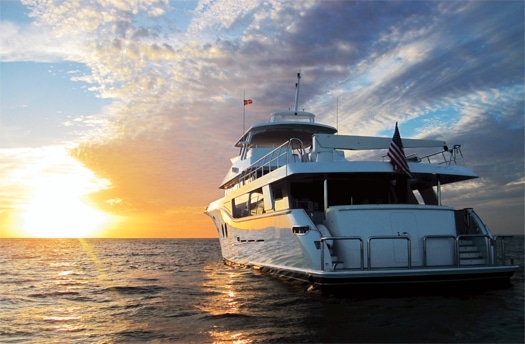
| | |
This design also contributes to efficiency at lower speeds: “It’s round like a sailboat until you get back to here,” says Adams, pointing to the midpoint of the hull model where the hard chine begins. “At low speeds she glides beautifully, so that’s why we can get 1.2 nautical miles to the gallon at 8 knots.”
You can have the best design in the world on computer screens and drawings, but if it isn’t properly executed, the results will disappoint. Adams feels strongly that the finish of this yacht is up to his standards, and he spent 330 days in China one year to make certain it stayed that way. “We’ve heard industry people say ‘This does not look like it was built in China.’ We’ve gotten a lot of compliments,” says Adams. “But what we want to do is try to get the customer to understand, that just like American boats-every boat built in America is not the same-every boat built in China is not the same.”
The wood joinery in the saloon reinforces his point. Long sections of cabinet trim go through multiple curves, with nary a butt joint to be seen. The single piece, more than 10 feet long, is manufactured by Tricon craftsmen. “I’ve had butt joints from really high quality yacht builders open up in the first week,” says Adams. And even if the joints stay tight, the wood color changes at every joint as the grain changes direction. While the butt-joint method is accepted as industry standard, Adams says Argos Yachts is striving to set its own standard.
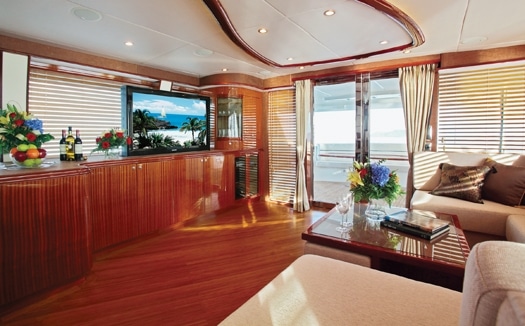
| | |
The 21-foot long saloon offers a U-shaped settee covered in a cream tweed and facing a cabinet concealing a pop-up 52-inch Samsung flatscreen. A bamboo sole promises durability and complements the glossy sapele mahogany trim throughout. Soft, distressed-finish leather is used as an accent on ceilings and locker tops. At the forward end of the saloon is the formal dining table, with seating for eight.
Down four steps from the saloon, the galley to starboard is finished in bamboo with stainless GE Profile appliances, a double sink, copious stowage, and a hatch in the sole leading to additional galley supplies belowdecks. The galley’s pocket door is held open or closed by a clever electromagnet, so the crew can be out of sight, as desired.
On the port side of the saloon is the entry to the SkySuite, the master stateroom with curving mahogany lockers and 270-degree views aft. The suite centers on a king-size berth with stowage beneath. A spacious walk-in closet is lined in cedar. His and hers heads are finished in marble and separated by a shower with rain nozzle. Adams insisted on billetting me there. Well, I really shouldn’t, but
The views from this stateroom are tremendous. I never closed the electric shades, instead enjoying the sweeping vistas and preferring dawn’s thin light to the whine of an alarm clock. At sunup, I looked across the immense boat deck outside my windows, sightlines unobscured by a skeletal set of stairs that grant access to the bridgedeck. A tender on the chocks will change the view, but it spent my stay on the dock. But enough lolling about: We had plans to go snorkeling and I wanted to see more of the G92 before we left.
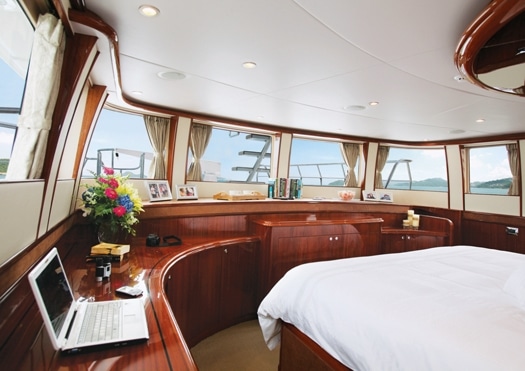
| | |
Beyond the galley door, the passageway offers access to a dayhead. Next is the VIP stateroom, lit by round hullside windows, with an en suite head with roomy shower. Forward of the VIP along that passageway are two more en suite double staterooms, laundry facilities, and stairs to the pilothouse. Crew quarters are in the bow, where a lounge offers a dinette, flatscreen, and a shared head. The captain’s cabin is equipped with a double berth and en suite head. A crew cabin offers upper and lower berths. Stairs lead to the pilothouse.
After lunch, we suited up on the swim platform. The breeze freshened, reminding me that it was the first week of January. I took a peek into the lazarette, faired with gleaming white gelcoat. With full standing height, this equipment space has plenty of stowage atop the propeller tunnels for gear and water toys. Adams said the whole design began with the engineroom. He wanted these spaces to be full height and provide easy access to all equipment. The wiring and plumbing were seamanlike and neatly labeled throughout the yacht. I could look at tidy wiring all day-but it was time to go snorkeling.
As we passed the breakwater, the seas kicked up and the breeze was reenergized. Adams pointed to a nearby islet and said we would try there, where he had anchored the G92 for swimming and snorkeling a few days prior. Turned out the current was ripping beneath leaden skies, but I pulled on my fins and slipped into the water, finding less than seven feet of depth. I looked at the skeg of the skiff ‘s outboard- it seemed shallow here for this boat, never mind a 92-footer.
After fighting the current for the afternoon, resting only when I climbed aboard the skiff, I was ready for a little relaxation. Returning to the Argos, we hit the four-person spa tub on the bridgedeck. A few minutes in the bubbles and my muscles relaxed and warmed up-a cold beer took the edge off my fatigue. This bridgedeck has everything for entertaining: barbecue grill, large dinette, and service bar, all beneath a hardtop. A centerline helm has helm and companion seats and, to port, a sliding hatch-door down to the pilothouse.
Following my soak in the hot tub, I made my way through the pilothouse as I headed for the SkySuite to dress for dinner. Finished in a satin-finish sapele, the same distressed leather surfaces on cabinet tops, it has dogging doors on each side that lead to a Portuguese bridge. A raised dinette with black leather seating lets companions enjoy the sights, and two large multifunction displays are flanked by Caterpillar engine monitoring control heads. An overhead panel offers a schematic of the yacht equipped with red warning lights-an almost quaint addition in these days of touchscreen ship’s systems monitors. Good drawer space and chart stowage spaces are handy.
As I watched the last glow of sunset at that helm, I glanced over the chart of the Bahamas, left out from the previous evening. This sheet of paper tells a story: Pick your spots for a bluewater passage, feeling swells from a storm half an ocean away. Chart your route over flats where a single fathom of depth (sounded who knows when?) is the least one needs to make it through. Adventure awaits, and I couldn’t help wishing that we were making ready for just such a journey.
Argos Yachts, (416) 907-0869; **www.argosyachts.com**









